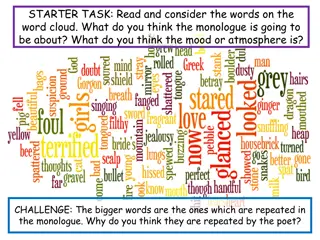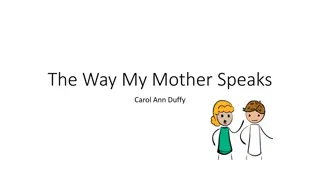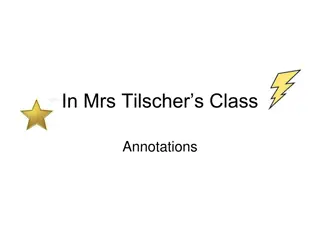Understanding "The Way My Mother Speaks" by Carol Ann Duffy
Exploring the nuances of Carol Ann Duffy's poem "The Way My Mother Speaks," this analysis delves into the context, themes, and stanzas of the work. The poem revolves around the journey from childhood to adulthood, emphasizing the transition from dependence on a mother to the formation of individual identity, all conveyed through the lens of language and personal connection. Readers are encouraged to engage with the text, identify key themes, and reflect on the poet's exploration of change, nostalgia, love, and identity.
Download Presentation

Please find below an Image/Link to download the presentation.
The content on the website is provided AS IS for your information and personal use only. It may not be sold, licensed, or shared on other websites without obtaining consent from the author. Download presentation by click this link. If you encounter any issues during the download, it is possible that the publisher has removed the file from their server.
E N D
Presentation Transcript
THE WAY MY MOTHER SPEAKS Higher PPT
Learning Intentions To understand the context of The Way My Mother Speaks. To have analysed each stanza. To identify key themes/ideas, and discuss these in relation to the text. To be able to identify compare this poem to the other poems we have studied.
Context In this poem the poet/persona = on a train heading to England. Journey is both literal and metaphorical, as here Duffy is concerned with the transition between childhood and adulthood, from dependence to independence, from seeing herself as being closely tied to her mother to then forming her own identity. Like Originally and In Mrs Tilscher's Class, Duffy explores how change causes conflicting emotions, which is why this poem is full of contradictions and contrasts. The poem's title could imply "the way" her mother speaks in terms of her use of dialect and set expressions. The poem ends on a note of optimism insisting that you can be "free" but also still connected to your background and family.
Reading the Poem I will first read through the poem with you. If there are words/phrases that you don t understand, underline them as we read through we can discuss them at the end.
Your Turn Read the poem on your own at least twice. In your jotters, make a note of any key themes or key ideas that you notice. Be prepared to justify your choice. Example: Isolation, Love
Themes Transition/Change Movement Childhood Experiences Nostalgia Love Identity (national and personal) Sexuality Safety/Security
Stanza One I say her phrases to myself in my head or under the shallows of my breath, restful shapes moving. The day and ever. The day and ever.
Duffy writes in 1st person + reader is immediately drawn into her personal thoughts and feelings. Links herself with her mother in a sentence that mixes "her phrases" with "myself" and "my head". "Her = possessive suggesting the words belong to her mother but the fact they are in my head clearly shows a deep and personal bond b/w them. I say her phrases to myself in my head or under the shallows of my breath, Duffy is saying the words quietly to herself. Shallow breathing suggests anxiety - she is nervous on this journey, perhaps repeating her mother s words to comfort herself. "shallows" = connotations of water + recalls the sound waves themselves merging with the poet's own breathing mother's sayings are integral to her very existence. implies her
Words become "restful shapes moving," moving links the words with the journey. Relates to the journey taking place, as scenes and landscapes that are still or resting seem to move when viewed from a train. "restful" and "moving" = a contradiction which alludes to the fact that on a train you seem to be still while the rest of the world races past you. Although it is Duffy who is on a journey, this seems like a moment of stillness and reflection while it is the world that changes around her. "Moving" can also be seen in another sense, suggesting the poet s feelings - the phrases and journey are emotionally moving. daughter soothed by them. restful shapes moving. The day and ever. The day and ever. Repeating phrase = suggests sound of the train, as mimics the rhythm of the travelling train. Also suggests the poet repeating the words to herself, calming herself. Italics stress the importance of the phrase and show that this is a direct quotation - one of the mother s phrases. WC "ever" at the end of phrase refers to eternity, as if this journey will last her whole life and this connection with her mother will always be there.
*Enjambment used throughout Poem Mimics the fluidity and constant movement of the train/and the fact that she is continuously moving through life.
Stanza Two The train this slow evening goes down England browsing for the right sky, too blue swapped for a cool grey. For miles I have been saying What like is it The way I say things when I think. Nothing is silent. Nothing is not silent. What like is it.
fell through the fields one of them bawling, Home,/ Home the miles rushed back to the city,/ the street, the house, the vacant rooms/ where we didn t live anymore. Some are slow,/ leaving you standing, resigned, up an avenue/ where no one you know stays. Others are sudden./ Your accent wrong.
Timed Paper Next Thursday 13th December. No notes! Will get 45 minutes to complete.
Final week revision work only or another timed paper + revision? Likely that your prelim will take place in 2nd week of next term! (I have been off so don t know if it s been confirmed)
Refers in more detail to the train journey H/W the journey seems to be taking forever. The evening is "slow suggesting that time itself has stretched, and that she has the chance to think and reflect. The use of long vowel sounds in "slow", "goes down" and slows the pace of the words adding to the leisurely mood. a she sets the time and the place. Assonance highlights more contradiction + confusion in the persona s feelings. The train this slow evening goes down England browsing for the right sky, too blue swapped for a cool grey. Contrast between colours "blue" and "grey" reflect both a real and a metaphorical change move from blue to grey = change from day to night on this evening journey, as well as the move from child to adult. "too blue" could represent childhood = connotations of sunshine and happiness "cool grey" suggests the uncertainty of becoming an adult life is becoming darker. "Browsing" suggests that the train hasn t quite decided where it is going - the poet is not sure of her destination. Could reflect the idea of a young person leaving home, trying things out and looking for a new place in life. The fact that she is still trying to find "the right sky" implies that she is yet to find a way of life that suits her.
Miles = connotations of distance, movement Demonstrates how far she has come both in her physical and emotional journey. For miles I have been saying What like is it The way I say things when I think. Duffy says that these words come to her when she 'thinks inner voice is linked to her mother s. These phrases repeat themselves in her head. She is not speaking them out loud. Shows just how much of an effect her mother had on her development: she is still within her thought processes. Mother's voice emerges another of her phrases. Again italics show speech. Again - phrase repeats and suggests the sounds of the train. conveys her
R/ship between internal and external dialogue explored further in the line. Repetition of "nothing" connects the two short sentences. The double negative in the second implies that, what doesn't exist in the here and now (your memories, your past) still has a voice in your head. It still has influence. Nothing is silent. Nothing is not silent. What like is it. Repetition ingrained these phrases are. She cannot let go of them they are a part of her way of thinking and life. demonstrates how deeply
Stanza Three Only tonight I am happy and sad like a child who stood at the end of summer and dipped a net in a green, erotic pond. The day and ever. The day and ever. I am homesick, free, in love with the way my mother speaks.
only tonight = asserts that this transition, this journey is a singular experience. She then expresses contradictory, uncertain emotions. Perhaps she is sad to be leaving her mother behind or even mourning the end of her childhood. But she is also positive about what the future holds for her and that fact she still has this connection with her past to take with her. Only tonight I am happy and sad like a child who stood at the end of summer Compares her feelings of moving from childhood to adulthood, to the change of seasons. It is the "end of summer which links back to her switching the "too blue" sky for "cool grey". The delight and innocence of childhood is ending.
Alludes to the archetypal image of a child by the frog pond, but this time it is a "green, erotic pond". Slight contradiction here as "green" has connotations of naivety while "erotic" connotes a more adult them This juxtaposition could reflect the innocent child coming face to face with the wider world. jars in reader s mind. and dipped a net in a green, erotic pond. The day and ever. The day and ever. Perhaps because of this, she returns to her mother's phrases "The day and ever", repeating them like a comforting mantra. No matter what she has to confront, she has her mother's voice within her, giving her strength. Repetition mimics the movement of train well as creating comfort. creates sense of place as
Unites some of the contradictions from earlier in the poem. Homesick negative connotations of dissatisfaction, fear, discontent. Free + love positive connotations of escape, independence, reverence. She is "homesick" for her childhood, her past, her mother, but she also feels "free" to establish her new identity, to stride forward, to continue travelling "down England" and further. I am homesick, free, in love with the way my mother speaks. Enjambment leaves idea hanging for a moment, as if she is "in love" with life, a love which was given to her earlier by her mother. Final line then confirms this returns to title + tells us she is pleased to have such a bond with her past. She loves that in this "slow evening" her mother's voice comes back to her and will continue to do so for "ever."
Form and Structure In the first stanza, she describes repeating her mother s words in her head and under her breath. This suggests that they are bound up with her own self. This union between mother and daughter is emphasised by the brevity of the stanza and the inclusion of the two women in it. The next two stanzas then, could represent the 'journey' or the different stages ahead of the speaker in becoming an adult, which she embarks on, equipped with the close connection she had with her mother.
Textual Analysis Questions 1. Identify the tone present within this poem. Through reference to at least two poetic techniques, explain how this tone is developed. (4 marks) 2. How effective do you find the final stanza as a conclusion to the poem? (2 marks) 3. With reference to at least two poetic techniques, explain how Duffy use childhood experience to explore the theme of change. (4 marks) 4. With reference to at least two poetic techniques, explain how Duffy uses comparison to develop the theme of transition/change. (4 marks) 5. Look at The Way My Mother Speaks. With reference to this poem, and at least one other by Duffy, explain how the poem reinforces a sense of nostalgia. (10 marks)
Any questions you have about any of the texts or anything you would like to focus on write them on a post-it. I will use this to provide focus for next weeks study period. Remember: Thursday = Timed Paper

























